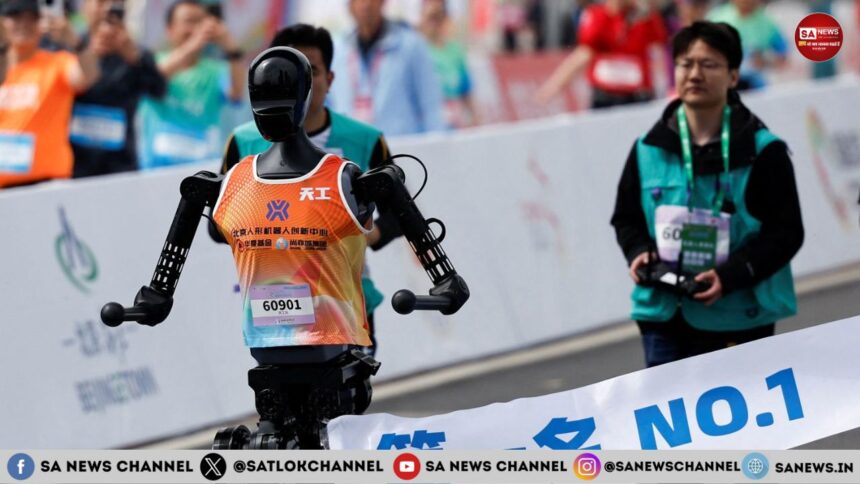On April 19, 2025, China made history by hosting the world’s first humanoid robot half-marathon in Beijing. This unique event saw 21 humanoid robots competing on a 21-kilometer track alongside human runners, marking a significant milestone in the evolution of robotics and artificial intelligence. The event not only demonstrated the capabilities of humanoid robots but also provided a glimpse into the potential future applications of robotics in various industries.
- What Was the Humanoid Robot Half-Marathon?
- The Competition: Who Finished and What Went Wrong?
- Why Does This Matter for the Future?
- Advancements in Robotics and AI
- The Need for Further Advancements
- The Future of Robotics in Everyday Life
- Conclusion: A Step Toward the Future of Robotics
- A Step Toward the Future of Robotics — With a Deeper Reflection
The event, showcasing advanced technology and engineering, attracted the interest of both technology aficionados and the wider audience. As the robots raced to the finish line, they highlighted both the advancements and limitations in the world of robotics today. Let’s dive deeper into the details of this groundbreaking event and what it signifies for the future of robotics and AI.
What Was the Humanoid Robot Half-Marathon?
A Historic Event for Robotics and AI
The humanoid robot half-marathon in Beijing wasn’t just a race—it was an exhibition of advanced engineering and artificial intelligence. Held on April 19, 2025, the event marked the first time robots were put to the test in a competitive race alongside human runners. The robots, developed by leading Chinese manufacturers like DroidVP and Noetix Robotics, varied in shape and size, with heights ranging from 1.2 meters to 1.8 meters.
The goal was not just to see which robot could cross the finish line first but to assess their performance in a challenging, real-world scenario. Each robot was tested on factors such as speed, endurance, and navigation—all while operating autonomously, with teams on hand to provide support as needed.
Robotic Technology on Display
These humanoid robots were designed with a focus on human-like features, such as the ability to mimic facial expressions, including smiling and winking. Some robots even had the capacity for complex movement patterns, like walking and running. Each team spent weeks perfecting the design, ensuring that the robots could perform optimally on the track.
While the robots came from different manufacturers and varied in their technological capabilities, they all shared a common goal: to complete the 21-kilometer race within the set four-hour timeframe.
The Competition: Who Finished and What Went Wrong?
The Winner: Tiangong Ultra
Despite the technical challenges that arose during the race, four robots successfully completed the marathon, showcasing the impressive capabilities of these machines. The exceptional performer was Tiangong Ultra, a humanoid robot created by the Beijing Innovation Center for Human Robotics. It completed the race in 2 hours and 40 minutes, becoming the first humanoid robot to achieve this feat.
Tiangong Ultra’s victory was a testament to the progress made in humanoid robotics. With its advanced design and high-performance capabilities, it stood out as a leading example of how robots might one day be able to handle complex tasks in real-world environments.
Technical Issues and Challenges
However, not all robots were able to finish the race without complications. Many faced technical issues that caused them to collapse or struggle with the physical demands of the marathon. Some robots required assistance from their technical teams to continue the race, leading to a recognition of the limitations in current robotic technology.
Despite these setbacks, the event highlighted the areas where improvement is needed—such as robot stability, battery life, and endurance. The challenges faced by some of the robots were a reminder that while significant strides have been made, there is still much work to be done before humanoid robots can perform in real-world situations reliably.
Why Does This Matter for the Future?
Advancements in Robotics and AI
The humanoid robot half-marathon is more than just a novelty event—it represents a leap forward in the field of robotics and artificial intelligence. As humanoid robots become more advanced, they will have applications in industries ranging from healthcare and manufacturing to entertainment and service sectors. The event demonstrated how robotics can perform tasks that require complex physical abilities and adaptability.
The Need for Further Advancements
While the race was a success in terms of showcasing the robots’ capabilities, it also underscored the need for further advancements in stability, endurance, and autonomy. The robots that struggled during the race showed that there is still much to learn about creating machines that can handle the physical and environmental challenges of real-world tasks.
The Future of Robotics in Everyday Life
As technology continues to improve, it’s likely that humanoid robots will play an increasingly significant role in various aspects of our daily lives. Whether it’s assisting in disaster recovery, working in hazardous environments, or helping people with disabilities, the possibilities are vast. The humanoid robot half-marathon is just one example of how robotics will continue to evolve and integrate into society.
Conclusion: A Step Toward the Future of Robotics
The world’s first humanoid robot half-marathon held in Beijing on April 19, 2025, was not just a race—it was a glimpse into the future of robotics and AI. With the successful completion of the race by Tiangong Ultra and the technical challenges faced by other robots, the event highlighted both the impressive advancements in humanoid robotics and the areas that need further development.
China’s ambition to lead in the field of robotics and artificial intelligence is evident, and this event serves as a testament to their commitment to pushing the boundaries of technology. While humanoid robots are still in the early stages of development, the progress showcased at this race suggests that they will soon play an important role in a variety of industries, shaping the future of automation, human interaction, and technological integration.
As robotics continues to evolve, we can expect even more remarkable achievements in the coming years. The humanoid robot half-marathon is just the beginning, and the future holds exciting possibilities for both technology and society.
So, keep an eye on the world of robotics—the best is yet to come!
A Step Toward the Future of Robotics — With a Deeper Reflection
The world’s first humanoid robot half-marathon held in Beijing on April 19, 2025, was more than just a showcase of technology—it was a vision of future possibilities. But as we advance in robotics and AI, it’s also important to reflect on why we pursue such innovation. According to the spiritual knowledge of Sant Rampal Ji Maharaj, true progress isn’t just about external achievements—it lies in understanding our real purpose as human beings. While humanoid robots may support our worldly tasks, they cannot answer deeper questions about life, death, or liberation (Moksha).
Sant Rampal Ji Maharaj teaches from all holy scriptures that devotion to the Supreme God Kabir Ji and living a righteous life is the path to true happiness—something machines can’t replicate. As we race toward technological wonders, let’s not forget the eternal truth revealed in our scriptures.
Explore more spiritual insights on Sant Rampal Ji Maharaj’s YouTube Channel.









